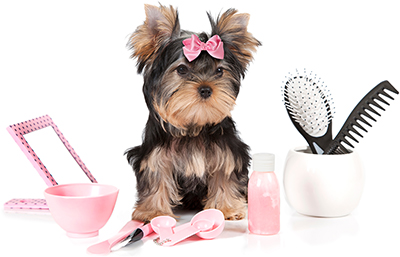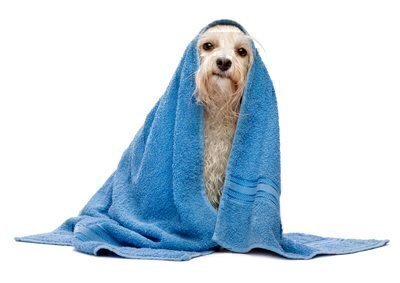Last updated July 2022
While your pup might not be ready for the Westminster Kennel contest, a good pet groomer can help you keep her coat, paws, and smell in winning order. Groomers can make Fluffy, well, fluffy by untangling or removing matted fur, styling her coat to breed standard or to your liking, banishing stinky odors and dirt with shampoo, and trimming your feisty friend’s nails. Good groomers will save you time and hassle, whether you’ve got a pup with an easy-to-maintain flat coat (beagles, pugs) or a fuzzy breed that requires a pro to maintain its ’do (Afghan hounds, standard poodles). They can also take care of smelly cats.
 A professional grooming session typically includes:
A professional grooming session typically includes:
- Bath and blow dry
- Brushing
- Nail trimming
- Ear cleaning
- Cleaning around eyes
- Hair trim or cut—how much work this involves depends on the breed
- Cleaning anal sacs—this helps prevent them from becoming compacted.
How often your pet needs to be groomed depends on breed, size, coat type, and your own standards. Professional groomers argue that all pooches benefit from regular visits because this helps maintain their overall health. This is, of course, a self-serving claim, but there’s some truth in it: Consistent grooming improves hygiene and means Fido will be periodically inspected by someone who sees a lot of dogs and can spot potential health problems. Also, frequent grooming helps keep your pet’s coat in good condition, resulting in easier and less-expensive appointments (with some breeds, wait too long and the coat can become too matted to save, and they’ll suffer the full shave of shame).
For some breeds, there is such a thing as too much grooming. Too-frequent baths can remove natural oils in a dog’s coat or skin, making it dry and raw. Before setting a regular grooming schedule, ask your vet how often they recommend grooming for your pet. Need a vet for your pet? Click here for ratings of local practices for quality and price.
Groomers work in dedicated pet salons as well as for pet stores, boarding kennels, and at some veterinary practices. There are also mobile operations that come to your home and do the work in specially equipped trucks or vans.
Here are tips on how to find the right groomer, at the right price:
Get referrals. Good sources of intel are your vet, friends, neighbors, and co-workers. Of course, also check the reviews we’ve collected from area consumers. Although a large majority of the ratings submitted to us for grooming operations are positive, we also receive a disturbingly large number of comments that warn of rough treatment, including injured animals, sloppy work by untrained staff, and rude service.
Compare prices. Even among highly recommended groomers, you’ll find a wide range of pricing. The table below reports prices Checkbook’s undercover shoppers were quoted by a sample of area outfits to groom (including haircut) a cocker spaniel and a golden retriever. We were quoted price ranges from $54 to $80 or more for the cocker spaniel and $48 to $95 or more for the golden retriever. Don’t assume that low prices signify lousy work—several of the least expensive groomers received high marks from their surveyed customers.
Experience counts. You wouldn’t want your hair cut by a newbie. An experienced dog groomer has also had time to perfect the craft and become an expert at assessing dogs’ behavior and responding appropriately to nervousness and agitation. Also ask whether the groomer is familiar with your breed—even highly experienced pet pros won’t have extensive experience with all of them. The best groomers will be upfront about their limitations and, if necessary, direct you to another groomer who knows the breed better.
Check training and credentials. Several organizations certify dog groomers, including the National Dog Groomers Association of America and the International Society of Canine Cosmetologists. Certification from either means a groomer attended classes and then passed a series of written and practical exams. Since the amount of time and effort required for certification is substantial, certification does indicate a groomer is serious about their profession and possesses at least the basic skills for the job. On the other hand, many talented, experienced groomers haven’t bothered to take the time or pay the fees to become certified.
Discuss your expectations. Do you want basic grooming services, with no concern that your dog’s trim meets exacting breed-specific standards? Or do you have much higher expectations—a scissored haircut, a sculpted trim, or hand stripping for a terrier? If you have a certain look in mind, share photos with the groomer.
Check whether you can watch the grooming. You’ll learn a lot about how the staff treats your dog and other pups if you watch groomers in action. If you can’t be in the same room, grooming tables that are in full view of the reception area are a plus.
 Take a tour. Each dog should have its own space and access to clean water. If dogs are positioned under blow dryers and left to dry instead of hand-dried, staff should be able to easily monitor the area so dogs do not become overheated or burned. Cage drying is controversial; many in the industry argue that these dryers shouldn’t be used because they can cause stress or health problems. Short-muzzled pups such as bulldogs, Lhasa Apsos, and pugs are prone to overheating as are very young or senior animals of any breed.
Take a tour. Each dog should have its own space and access to clean water. If dogs are positioned under blow dryers and left to dry instead of hand-dried, staff should be able to easily monitor the area so dogs do not become overheated or burned. Cage drying is controversial; many in the industry argue that these dryers shouldn’t be used because they can cause stress or health problems. Short-muzzled pups such as bulldogs, Lhasa Apsos, and pugs are prone to overheating as are very young or senior animals of any breed.
Size up the staff. Does everyone seem to be knowledgeable and caring? Are they willing and able to answer any questions you have?
Check whether they take steps to prevent the spread of disease. They should require vaccination records.
Ask about their plan for health emergencies. Will they rush your dog to a veterinarian, if necessary?
Consider the convenience of pickup/drop-off arrangements. Most groomers require appointments. You can usually drop off dogs in the morning and pick them up before the shop closes. While this arrangement is convenient for most pet owners, it means your dog will have to spend the entire day at the facility.
Some groomers require customers to pick up their pets at designated times. This isn’t as convenient an arrangement for most dog owners as open drop-off/pickup times, but a scheduled grooming appointment does shorten your dog’s stay at the groomer.
If your dog becomes very upset when visiting a groomer, consider using a mobile grooming operation, which generally offers one-on-one service, minimizing exposure to other dogs and keeping the process shorter.
Avoid groomers who sedate animals. Even if your pet is extremely nervous about visiting the groomer, do not let the dog be sedated unless the sedation will be administered by a veterinarian who will then also monitor the dog’s care throughout the stay.


